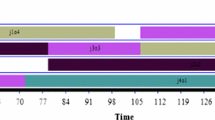Abstract
Today’s global environment is highly competitive. The competition between two firms means the competition in their supply chain. The prime objective of decision makers are to optimize the supply chain. In every stage of supply chain, the cost and delivery time are involved. These criteria are uncertain in nature. We express these criteria in either the triangular or trapezoidal fuzzy numbers. While optimizing the time and cost simultaneously, the problem becomes bi-objective. Such problems can be solved by using Multiple Objective Genetic Algorithm (MOGA). We get the different Pareto front at different α-cuts which is called as the Pareto decision space. According to the uncertainty in the market, decision maker has a choice to take decision among the set of alternatives. Here, the proposed solution methodology is fusion of fuzzy set theory and MOGA. Fuzzy set theory is used for uncertainty in parameters and MOGA is used for obtaining non-dominated solutions. The numerical example is given to illustrate the proposed methodology and industrial case study is solved by using proposed methodology.
Similar content being viewed by others
References
Amiri A (2006) Designing a distribution network in a supply chain system: formulation and efficient solution procedure. Eur J Oper Res 171(2):567–576
Back T, Fogel D, Michalewicz Z (1997) Handbook of evolutionary computation. Bristol: Institute of Physics publishing and New York Oxford University press
Beamon B (1998) Supply chain design and analysis: models and methods. Int J Prod Econ 55(3):281–294
Bhattacharya R, Bandyopadhyay S (2010) Solving conflicting bi-objective facility location problem by NSGA-II evolutionary algorithm. Int J Adv Manuf Technol 51:397–414
Bandyopadhyay S, Bhattacharya R (2013) Applying modified NSGA-II for bi-objective supply chain problem. J Intell Manuf 24:707–716
Chakraborty M, Ray A (2009) Parametric approach and genetic algorithm for multi-objective linear programming with imprecise parameters. OPSEARCH 47:73–92
Chen C, Lee W (2004) Multi-objective optimization of multi-echelon supply chain networks with uncertain product demands and prices. Comp Chem Eng 28:1131–1144
Deb K (2000) An efficient constraint handling method for genetic algorithms. Computer Methods Appl Mech Eng 186:311–338
Deb K (2005) Multi objective optimization using evolutionary algorithms. Wiley
Diabat A, Deskoores R (2016) A hybrid genetic algorithm based heuristic for an integrated supply chain problem. J Manuf Syst 38:172–180
Dutta P, Chakraborty D, Roy A (2005) A single-period inventory model with fuzzy random variable demand. Math Comput Model 41:915–912
Fonseca C, Fleming P (1993) Genetic algorithms for multi-objective optimization: formulations, discussion and generalization Proceedings of the Fifth International Conference: Morgan Kauffmann
Gen M, Cheng R (1997) Genetic algorithms and engineering design. Wiley, New York
Goldberg D, Richardson J (1987) Genetic algorithms with sharing for multimodal function optimization. Proceedings of Second International Conference on Genetic Algorithms at Lawrence Erlbaum:41–49
Goldberg D (1989) Genetic algorithms for search optimization, and machine learning. Addison Wesley, Reading, MA
Holland J (1975) Adaptation in natural and artificial systems. MIT press, Arbor, MI
Jayaraman V, Pirkul H (2001) Planning and coordination of production and distribution facilities for multiple commodities. Eur J Oper Res 133:394–408
Jayaraman V, Ross A (2003) A simulated annealing methodology to distribution network design and management. Eur J Oper Res 144:629–645
Jiang D, Haitao L, Yang T, De Li (2016) Genetic algorithm for inventory positioning problem with general acyclic supply chain networks. Eur J Indust Eng 10(3):367–384
Latpate R, Bajaj V (2011a) Fuzzy programming for multi-objective transportation and inventory management problem with retailer storage. Int J Agric Stat Sci 7(1):377–326
Latpate R, Bajaj V (2011b) Fuzzy multi-objective, multi-product, production distribution problem with manufacturer storage. Proc Int Congress PQROM 2011:340–355
Latpate R (2014) Fuzzy modified TOPSIS for supplier selection in supply chain management. Int J Innov Res Comput Sci Technol 3(4):22–28
Liang TF (2011) Application of fuzzy sets to manufacturing/distribution planning decisions in supply chains. Inf Sci 181:842–854
Liang TF (2008) Fuzzy multi-objective production/distribution planning decisions with multi-product and multi-time period in a supply chain. Comput Indust Eng 55:676–694
Michalewicz Z, Schoenauer M (1996) Evolutionary algorithms for constrained parameter optimization problems. Evol Comput 4(1):1–32
Mitchelle M (1996) Introduction to genetic algorithms. MIT press, Ann Arbor, MI
Moncayo-Martinez LA, Ramirez-Lopez A, Recio G (2016) Managing inventory levels and time to market in assembly supply chains by swarm intelligence algorithms. Int J Manuf Technol 82:419–433
Moncayo-Martinez LA, Zhang DZ (2011) Multi-objective ant colony optimisation: a meta-heuristic approach to supply chain design. Int J Prod Econ 131:407–420
Moore G, Revelle C (1982) The hierarchical service location problem. Manag Sci 28(7):775–780
Murata T, Ishibuchi H (1995) MOGA: Multi-objective genetic algorithms. In: Proceedings of the second IEEE International Conference on Evolutionary Computation, pp 289–294
Osyczka A, Kundu S (1995) A new method to solve generalised multicriteria optimization problems using the simple genetic algorithm. Struct Optim 10:94–99
Razaei J, Davoodi M, Tavasszy L, Davarynejad M (2016) A multi-objective model for lot sizing with supplier selection for an assembly system. Int J Logist Res Appl 19(2):125–142
Sabri E, Beamon B (2000) A multi-objective approach to simultaneous strategic and operational planning in supply chain design. Omega 28:581–598
Sadeghi J, Sadeghi S, Niaki STA (2014) A hybrid vendor managed inventory and redundancy allocation optimization problem in supply chain management: An NSGA--II with tuned parameters. Comput Oper Res 41:53–64
Shen Z (2007) Integrated supply chain design models: a survey and future research directions. J Indust Manag Optim 3(1):1–19
Syam S (2002) Model and methodologies for the location problem with logistical components. Comp Op Res 29:1173–1193
Syarif A, Yun Y, Gen M (2002) Study on multi-stage logistics chain network: a spanning tree-based genetic algorithm approach. Comput Indust Eng 43:299–314
Tan KC, Lee TH, Khor EF (2002) Evolutionary algorithms for multi-objective optimization: performance assessments and comparison. Artif Intell Rev 17:253–290
Truong TH, Azadivar F (2005) Optimal design methodologies for configuration of supply chains. Int J Prod Res 43(11):2217–2236
Tsai J, Liu T, Chou J (2004) Hybrid Taguchi Genetic algorithm for global numerical optimization. IEEE Trans Evol Comput 8(4):365–377
Vidal C, Goetschalckx M (1997) Strategic production-distribution models: a critical revies with emphasis on global supply chain models. Eur J Oper Res 98(1):1–18
Vose M (1999) Simple genetic algorithms: foundation and theory. MIT press, Ann Arbor, MI
Weber A (1909) Uber den standort der industries, translated as Alfred Weber’s theory of location of industries. University of Chicago press, Chicago
Yan H, Yu Z, Cheng TCE (2003) A strategic model for supply chain design with logical constraints: formulation and solution. Comput Oper Res 30(14):2135–2155
Wei-Chang Y, Mei-Chi C (2011) Using multi-objetcive genetic algorithm for partner selection in green supply chain problems. Expert Syst Appl 38:4244–4253
Yuce B, Pham DT, Packianather M, Mastrocinque E (2015) An enhancement to the Bees Algorithm with slope angle computation and Hill Climbing Algorithm and its applications on scheduling and continuous type optimisation problem. Prod Manuf Res 3(1):3–19
Yuce B, Mastrocinque E, Lambiase A, Packianather M, Pham DT (2014) A multi-objective supply chain optimisation using enhanced Bees Algorithm with adaptive neighbourhood search and site abandonment strategy. Swarm Evol Comput 18:71–82
Zadeh L (1965) Fuzzy sets. Inf Control 81:338–352
Zadeh L (1978) Fuzzy sets as basis for a theory of possibility. Fuzzy Sets Syst 1:3–28
Author information
Authors and Affiliations
Corresponding author
Rights and permissions
About this article
Cite this article
Latpate, R.V., Kurade, S.S. Fuzzy MOGA for supply chain models with Pareto decision space at different α-cuts. Int J Adv Manuf Technol 91, 3861–3876 (2017). https://doi.org/10.1007/s00170-016-9966-5
Received:
Accepted:
Published:
Issue Date:
DOI: https://doi.org/10.1007/s00170-016-9966-5




